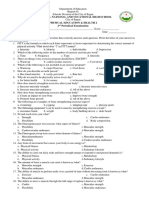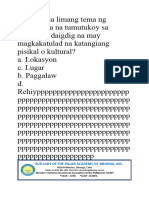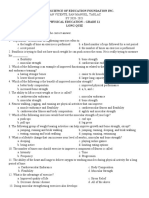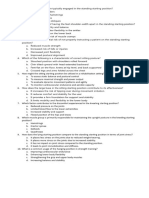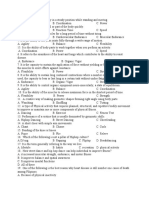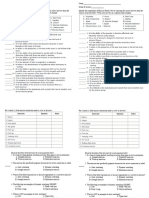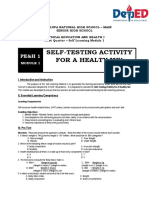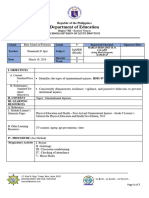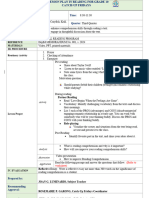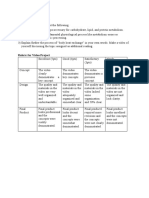First Long Test in SPS 7
First Long Test in SPS 7
Uploaded by
Dennmark IgutCopyright:
Available Formats
First Long Test in SPS 7
First Long Test in SPS 7
Uploaded by
Dennmark IgutCopyright
Available Formats
Share this document
Did you find this document useful?
Is this content inappropriate?
Copyright:
Available Formats
First Long Test in SPS 7
First Long Test in SPS 7
Uploaded by
Dennmark IgutCopyright:
Available Formats
First Long Test in SPS 7
(Special Program for Arts)
Name: ______________________________________________________ Grade/Section: ______________________________
Name of School: _____________________________________________________ District: _________________________
I. Multiple Choice. Read each following statement and choose the best answer. Write the letter of the correct answer on the Left side
of the number.
1. Which of the following is an example of manipulative skill?
A. Walking C. Balancing
B. Shooting D. Skipping
2. Which of the following refers to the movement that is simple and basic for participating in or performing
different types of physical activities?
A. Fundamental movement C. Fundamental movement activities
B. Fundamental movement skills D. Movement
3. Which is NOT a Fundamental Movement skill?
A. Locomotor Skills C. Psychomotor Skills
B. Stability Skills D. Manipulative Skills
4. The following are examples of Locomotor Skills, EXCEPT .
A. Walking C. Sliding
B. Catching D. Running
5. What Fundamental movement skill is use in maintaining balance on spot or when moving?
A. Locomotor Skills C. Psychomotor Skills
B. Stability Skills D. Manipulative Skills
6. This Fundamental Movement Skill is used for controlling small objects.
A. Locomotor Skills C. Psychomotor Skills
B. Stability Skills D. Manipulative Skills
7. The following are examples of Locomotor Skills, EXCEPT .
A. Walking C. Sliding
B. Catching D. Running
8. A basketball player is practicing a three-point-shoot in their training. What particular fundamental movement
skill is being developed by the player?
A. Locomotor Skills C. Psychomotor Skills
B. Stability Skills D. Manipulative Skills
9. A girl stumbled (fall) after trying to make a quick spike in a certain match. What fundamental movement skill
must be developed to avoid such event?
A. Locomotor Skills C. Psychomotor Skills
B. Stability Skills D. Manipulative Skills
10. This Fundamental Movement Skill is used for travelling from one place to another.
A. Locomotor Skills C. Psychomotor Skills
B. Stability Skills D. Manipulative Skills
11. Which of the following is true?
a. Isotonic contractions generate force by changing the length of the muscle.
b. Isotonic contractions generate force without changing the length of the muscles.
c. Isotonic contractions cause muscles to shorten
d. Isotonic contractions only elongate muscles.
12. Which of the following are the antagonistic pair ?
a. Deltoids and triceps c. Biceps and triceps
b. Deltoids and biceps d. deltoids and pectorals
13. Which of the following produces isotonic contractions?
a. Chest pass C. shot put
b. Javelin throw D. Rowing
14. Which of the following results in elongation of muscles?
a. Eccentric C. Concentric
b. Isotonic D. Isometric
15. Which of the following shortens the muscles?
a. Eccentric C. Concentric
b. Isotonic D. Isometric
16. Which of the following is NOT true?
a. An isotonic concentric contraction results in the muscle shortening,
b. an isotonic eccentric contraction results in the muscle lengthening.
c. During an isometric contraction the muscle is under tension.
d. During isometric contraction the muscle shortens or lengthens.
17. Which of the following shortens or elongates muscles?
a. Eccentric C. Concentric
b. Isotonic D. Isometric
18. Which of the following is a chest muscle?
a. Pectoral c.biceps
b. Deltoids d.triceps
19. Which of the following resembles a push up motion ?
a. Rowing c. Shot put
b. Javelin throw d. Chest pass
20. Which of the following is NOT true?
a. A muscle fiber generates tension through actin and myosin cross-bridge cycling.
b. While under tension, the muscle may lengthen, shorten, or remain the same.
c. Contraction implies shortening, when referring to the muscular system.
d. Contraction means the generation of energy within a muscle fiber.
21. It is an imaginary point around which body weight is evenly distributed.
A. Center of Energy C. Center of Gravity
B. Center of Mass D. Center of Acceleration
22. Which of the following refers to the rotational momentum and is created by the rotations of the various
body segments?
A. Linear Momentum C. Range Momentum
B. Fundamental movement D. Angular Momentum
23. Which of the following statements below really define Correct Biomechanics.
A. Creates good place to do sports.
B. Provide efficient movement and may reduce the risk of injury.
C. Improve confidence in moving and executing sports.
D. Maximizes humeral internal rotation velocity.
24. Which of the following refers to the ability to control the body while the body is stationary.
A. Static Balance C. Dynamic Balance
B. Straight Balance D. Manipulate Balance
25. What Newton’s Law of Motion which states that for every action (force) there is an equal and opposite
reaction force?
A. Law of Inertia C. Law of Attraction
B. Law of Acceleration D. Law of Reaction
26. This states that objects tend to resist changes in their state of motion
A. Law of Inertia C. Law of Attraction
B. Law of Acceleration D. Law of Reaction
27. The following are examples of Biomechanics Skills, EXCEPT .
A. Running C. Cycling
B. Tennis D. Standing
28. Which of the following refers to the ability to maintain postural stability and orientation with center of
mass over the base of support and body at rest
A. Static Balance C. Dynamic Balance
B. Straight Balance D. Manipulate Balance
29. It is the study of the movement of living things using the science of mechanics.
A. Body Mechanics C. Human Mechanics
B. Biomechanics D. Mass Mechanics
30. Below are examples of Newton’s Law of Motion EXCEPT:
A. Law of Inertia C. Law of Attraction
B. Law of Acceleration D. Law of Reaction
You might also like
- E Book++500+Activities+ +english+ +update+15.02.2023Document133 pagesE Book++500+Activities+ +english+ +update+15.02.2023Jamile Ariele Cruz de AquinoNo ratings yet
- P.E. and Health 11 - First Quarter ExaminationDocument6 pagesP.E. and Health 11 - First Quarter ExaminationVhannie Acquiatan100% (10)
- Click Here For Download: (PDF) Aircraft Design: A Conceptual Approach (Aiaa Education Series)Document3 pagesClick Here For Download: (PDF) Aircraft Design: A Conceptual Approach (Aiaa Education Series)Nagô O Rei0% (1)
- Akzo Nobel Paint Colors ManualDocument1 pageAkzo Nobel Paint Colors ManualShesharam ChouhanNo ratings yet
- Long Quiz Midterm PATHFIT 1Document5 pagesLong Quiz Midterm PATHFIT 1Levi Argenio Caparic100% (1)
- College Pretest PE 1Document7 pagesCollege Pretest PE 1Jelyn Racel Agundo ElmedulanNo ratings yet
- Acceptability and Sensory Characteristics of Ampalaya PandesalDocument20 pagesAcceptability and Sensory Characteristics of Ampalaya PandesaltanginamotalagaNo ratings yet
- New Exam Grade 11Document6 pagesNew Exam Grade 11Jessieann Balmaceda Cabangan100% (1)
- Test Items and Answer KeysDocument5 pagesTest Items and Answer Keysrh206teNo ratings yet
- Pathfit 1 - Semi Final ExamDocument6 pagesPathfit 1 - Semi Final ExamDessa Gerremy P. VelezNo ratings yet
- Hope 11 q1 ReviewerDocument2 pagesHope 11 q1 Reviewer9pt4rygsc7No ratings yet
- Pretest Pe11 1st SemDocument2 pagesPretest Pe11 1st SemElyzee S Columbres100% (1)
- SSSSSSSSSLRC Let Materials MajorshipDocument61 pagesSSSSSSSSSLRC Let Materials MajorshipClara ArejaNo ratings yet
- Summative Test in Grade 11 Physical Education: Prepared By: Jorlan D. Magora Subject TeacherDocument5 pagesSummative Test in Grade 11 Physical Education: Prepared By: Jorlan D. Magora Subject TeacherElaizacon PagaygayNo ratings yet
- Biomechanics CH 6Document12 pagesBiomechanics CH 6M.HassamNo ratings yet
- G10-1st PERIODICAL TEST-MAPEH10Document3 pagesG10-1st PERIODICAL TEST-MAPEH10Rhyan KimNo ratings yet
- No-Logo-Physical Education 2 and 3 General Diagnostic Test-1Document4 pagesNo-Logo-Physical Education 2 and 3 General Diagnostic Test-1Glyze Allen Marie BordadoraNo ratings yet
- Grade11QuarterlyExam March2024Document4 pagesGrade11QuarterlyExam March2024Einstein JuliusNo ratings yet
- MULTIPLE CHOICE WPS OfficeDocument5 pagesMULTIPLE CHOICE WPS OfficeFurcy SarsozaNo ratings yet
- Page - 1Document3 pagesPage - 1Gijoy Mangalas Lozano100% (1)
- Exam-P e - 7Document3 pagesExam-P e - 7Josh DyNo ratings yet
- Pe 12Document3 pagesPe 12John Lloyd RegatoNo ratings yet
- Pre Test Pe 10Document2 pagesPre Test Pe 10lacdaoshantsNo ratings yet
- Diagnostic Test PEDocument3 pagesDiagnostic Test PEDonnie Ardez BurbosNo ratings yet
- Assessment in HopeDocument2 pagesAssessment in HopeNaddy RetxedNo ratings yet
- Semi Final QuizDocument23 pagesSemi Final QuizLady Mae AringayNo ratings yet
- Diagnostic Test in Hope 1Document3 pagesDiagnostic Test in Hope 1Irish Melody Dela FuertaNo ratings yet
- Practice Test in MapehDocument7 pagesPractice Test in MapehKris Mea Mondelo MacaNo ratings yet
- Pathfit 1 TQ Midterm ExaminationDocument4 pagesPathfit 1 TQ Midterm ExaminationKate Noreen Arsenal-CupinNo ratings yet
- School of Mount St. Mary: Health and Physical Education 12 First Periodical TestDocument4 pagesSchool of Mount St. Mary: Health and Physical Education 12 First Periodical TestJayson LabsanNo ratings yet
- P.E 2nd Quarter ExamDocument2 pagesP.E 2nd Quarter ExamCherry Vhim Flores Lanurias100% (3)
- Answer Key PE Reviewer Sept 2022 Set B.pdfsDocument13 pagesAnswer Key PE Reviewer Sept 2022 Set B.pdfsAlyssaMaeM CruzNo ratings yet
- Diagnostic For PE 11by Sir NoblezaDocument7 pagesDiagnostic For PE 11by Sir Noblezasukihajime2No ratings yet
- HOPE 1st Quarter ExamDocument4 pagesHOPE 1st Quarter ExamWiljhon Espinola Julapong100% (1)
- Pe&h Summative TestDocument3 pagesPe&h Summative TestHeeseung LeeNo ratings yet
- Anatomical Mechanical and Physiological Bases of MovementsDocument4 pagesAnatomical Mechanical and Physiological Bases of MovementsDJ JoeNo ratings yet
- Nderstands How Biomechanics Is Used To Improve TechniqueDocument4 pagesNderstands How Biomechanics Is Used To Improve TechniqueFrancis Ian Salinas MendozaNo ratings yet
- Summative Test in Health Optimizing Physical Education H.O.P.E 1Document4 pagesSummative Test in Health Optimizing Physical Education H.O.P.E 1Mylyn MinaNo ratings yet
- PE ExamDocument4 pagesPE ExamNimrod CabreraNo ratings yet
- PT - Music 6 - Q1Document4 pagesPT - Music 6 - Q1Roldan Agad SarenNo ratings yet
- 12 Pe - Assessment-DoneDocument4 pages12 Pe - Assessment-DoneCherry DelicaNo ratings yet
- No-Logo-Physical Education Secon Quarter Test-1Document4 pagesNo-Logo-Physical Education Secon Quarter Test-1Glyze Allen Marie BordadoraNo ratings yet
- HOPE 1 SUMMATIVE TESTDocument4 pagesHOPE 1 SUMMATIVE TESTdrazen.seguiNo ratings yet
- L.E.T.Reviewer Bped (P.E. & Health) Anatomical, Mechanical and Physiological Bases of MovementsDocument4 pagesL.E.T.Reviewer Bped (P.E. & Health) Anatomical, Mechanical and Physiological Bases of MovementsEmelrose LL MacedaNo ratings yet
- Test IDocument6 pagesTest IAngelica OcceñoNo ratings yet
- Hope 1 Summative TestDocument4 pagesHope 1 Summative Testdrazen.seguiNo ratings yet
- Pe 12 With Marking Scheme FDocument13 pagesPe 12 With Marking Scheme FStanleyNo ratings yet
- Hope 1 2ND Summative TestDocument5 pagesHope 1 2ND Summative TestJohn Rahzl NaradaNo ratings yet
- Physical Education and Health MidtermDocument3 pagesPhysical Education and Health Midtermmariatumbiga9No ratings yet
- Activity Sheet P.EDocument2 pagesActivity Sheet P.Eangielyn lucasan100% (1)
- PretestDocument2 pagesPretestnicole kirsten alvarNo ratings yet
- Mind StrainerDocument15 pagesMind Strainerchristian rojero100% (1)
- Carthel Science of Education Foundation IncDocument4 pagesCarthel Science of Education Foundation IncMonaliza PawilanNo ratings yet
- Caraso Mia Jeane - P.E 2 Midterm ExamDocument8 pagesCaraso Mia Jeane - P.E 2 Midterm ExamMìa Jeàne Torres CarasöNo ratings yet
- Quiz 1 KineDocument3 pagesQuiz 1 Kineptrsci100% (1)
- PE AND HEALTH - 9 CLUSTER A Summative Q1Document2 pagesPE AND HEALTH - 9 CLUSTER A Summative Q1Jyselle Mae M. BlancoNo ratings yet
- Grade 11 Diagnostic TestDocument3 pagesGrade 11 Diagnostic TestMaestro VoltzNo ratings yet
- PE QuizDocument3 pagesPE QuizRuthchel YaboNo ratings yet
- Self-Testing Activity For A Healty Me!Document8 pagesSelf-Testing Activity For A Healty Me!cathy domingoNo ratings yet
- High Intensity Training (HIT): How to build muscles in minutes - fast, efficient, and healthyFrom EverandHigh Intensity Training (HIT): How to build muscles in minutes - fast, efficient, and healthyRating: 5 out of 5 stars5/5 (1)
- How to Get That Booty: Unlocking the Secrets to a Strong and Shapely Rear EndFrom EverandHow to Get That Booty: Unlocking the Secrets to a Strong and Shapely Rear EndNo ratings yet
- Grade 9 Short Quiz PE 3rd QDocument3 pagesGrade 9 Short Quiz PE 3rd QDennmark IgutNo ratings yet
- Health 10 Catch Up FridayDocument2 pagesHealth 10 Catch Up FridayDennmark IgutNo ratings yet
- MAPEH 9 - 3rd COT LP 2024Document7 pagesMAPEH 9 - 3rd COT LP 2024Dennmark IgutNo ratings yet
- LP-Health-Education-10 Catch Up FridayDocument2 pagesLP-Health-Education-10 Catch Up FridayDennmark IgutNo ratings yet
- LP For Reading Week2Document2 pagesLP For Reading Week2Dennmark IgutNo ratings yet
- Project ATLETA Project Work Plan and Budget MatrixDocument2 pagesProject ATLETA Project Work Plan and Budget MatrixDennmark IgutNo ratings yet
- Project ATLETA Root Cause AnalysisDocument2 pagesProject ATLETA Root Cause AnalysisDennmark IgutNo ratings yet
- Badminton SolicitationDocument1 pageBadminton SolicitationDennmark IgutNo ratings yet
- 2020 - Dental CertificateDocument2 pages2020 - Dental CertificateDennmark IgutNo ratings yet
- HealthDocument16 pagesHealthDennmark IgutNo ratings yet
- 2020 Gallery of AthletesDocument6 pages2020 Gallery of AthletesDennmark IgutNo ratings yet
- National Students Day 2023Document8 pagesNational Students Day 2023Dennmark IgutNo ratings yet
- 2020 MedicalCertificate (Combative)Document1 page2020 MedicalCertificate (Combative)Dennmark IgutNo ratings yet
- 3rd Q LONG TEST IN HealthDocument2 pages3rd Q LONG TEST IN HealthDennmark IgutNo ratings yet
- Tentative List 8 MusselDocument3 pagesTentative List 8 MusselDennmark IgutNo ratings yet
- GSP Reg Form Sy2022 23 t1Document1 pageGSP Reg Form Sy2022 23 t1Dennmark IgutNo ratings yet
- Root Cause Analysis SampleDocument1 pageRoot Cause Analysis SampleDennmark IgutNo ratings yet
- Anarel B. TrenchiraDocument4 pagesAnarel B. TrenchiraDennmark IgutNo ratings yet
- Learning Tasks/Activities: Rubric For Video ProjectDocument3 pagesLearning Tasks/Activities: Rubric For Video ProjectDennmark IgutNo ratings yet
- Learning Task 4.2Document1 pageLearning Task 4.2Dennmark IgutNo ratings yet
- Sist en Iso 7346 2 1998Document9 pagesSist en Iso 7346 2 1998Dave ManimbenNo ratings yet
- Algebra: X y X M X MDocument22 pagesAlgebra: X y X M X MGulsara HasanovaNo ratings yet
- IB BIO 10.1 - MeiosisDocument21 pagesIB BIO 10.1 - MeiosisPerson AnonymousNo ratings yet
- Definition of HISTORYDocument4 pagesDefinition of HISTORYKaryl KayeNo ratings yet
- 2010-04 - 4E Adventure - L15 - The Maze of Shattered SoulsDocument27 pages2010-04 - 4E Adventure - L15 - The Maze of Shattered SoulsIzanagi No MikotoNo ratings yet
- Unit 5: Let's Measure! - 2: WorksheetDocument2 pagesUnit 5: Let's Measure! - 2: Worksheetphongtdt21411caNo ratings yet
- Present Simple PracticeDocument5 pagesPresent Simple PracticeAishahNo ratings yet
- PHY 212-QuantumMechanics-I PHY 513 Quantum Theory-I-Muhammad Sabieh AnwarDocument4 pagesPHY 212-QuantumMechanics-I PHY 513 Quantum Theory-I-Muhammad Sabieh AnwarMuhammadTahaNo ratings yet
- Lanette O NA. TDSDocument4 pagesLanette O NA. TDSRabah ABBASNo ratings yet
- Robotics Lab Manual FinalDocument39 pagesRobotics Lab Manual FinalSanthosh100% (4)
- JEE Mains 2023 Shift 1 Question Paper 11 Apr With Solutions PDFDocument28 pagesJEE Mains 2023 Shift 1 Question Paper 11 Apr With Solutions PDFSAUMIL SINHANo ratings yet
- Machine Elements Quiz 2Document15 pagesMachine Elements Quiz 2Quen CuestaNo ratings yet
- PresentationsmjjDocument18 pagesPresentationsmjjgaju619No ratings yet
- FSC Changes MIX Label TextDocument2 pagesFSC Changes MIX Label TextHanan ZayedNo ratings yet
- 2012E01 SaltLakewaterSupplyDocument13 pages2012E01 SaltLakewaterSupplyAbhishek AgarwalNo ratings yet
- Merkin - 1996 - TAM - Introduction To The Theory of Stability PDFDocument334 pagesMerkin - 1996 - TAM - Introduction To The Theory of Stability PDFzhangwenNo ratings yet
- VSD Affinity Laws and ApplicationsDocument32 pagesVSD Affinity Laws and Applicationsram_river808100% (2)
- Cranial Nerve ExamDocument20 pagesCranial Nerve ExamSIR ONENo ratings yet
- Interface Box High ULF-SBX-H TextDocument4 pagesInterface Box High ULF-SBX-H TextFailCucNo ratings yet
- Immobilization ExtricationDocument75 pagesImmobilization ExtricationJohn Britto100% (3)
- Medical Sociology 2017 PDFDocument114 pagesMedical Sociology 2017 PDFNegasi AtsbhaNo ratings yet
- LV Pre Int GrammarDocument1 pageLV Pre Int Grammar4myswagNo ratings yet
- Maximum Power Transfer Theorem Case 1 125274Document1 pageMaximum Power Transfer Theorem Case 1 125274akashdeep tickooNo ratings yet
- Butt Weld Fitting B16.9 A.403Document16 pagesButt Weld Fitting B16.9 A.403Jimmy ChanNo ratings yet
- LuftwaffeDocument1 pageLuftwaffepippo653111No ratings yet
- 9 El-Khazali Lead Controller DesignDocument39 pages9 El-Khazali Lead Controller Designs.a.s1d3233No ratings yet







